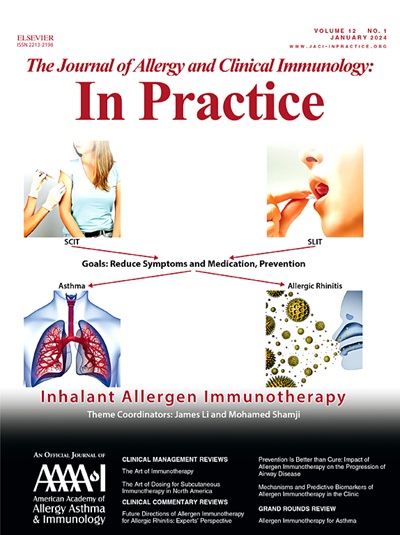Five Patients With Two Novel Homozygous Variants in CD3 Subunits and Comprehensive Review of the Literature
IF 8.2
1区 医学
Q1 ALLERGY
Journal of Allergy and Clinical Immunology-In Practice
Pub Date : 2025-06-01
DOI:10.1016/j.jaip.2025.03.022
引用次数: 0
Abstract
Background
CD3 subunit deficiency (CD3SD) causes combined immunodeficiency (CID) and severe CID (SCID).
Objective
To elucidate the clinical, laboratory, and genetic features of patients with different CD3SD subtypes.
Methods
We evaluated the data of five patients with CD3ε (two), CD3γ (two), and CD3δ (one) deficiencies from our institution. In addition, we reviewed the medical literature for cases of CD3SD.
Results
We identified two novel homozygous CD3 variants. In addition, we identified 44 CD3SD cases in the literature. In total, we analyzed the results of 49 patients. Our review of the medical literature revealed 11, 12, 18, and three patients with CD3ε, CD3γ, CD3δ, and CD3ζ deficiency, respectively. Of the 49 patients, 40 had an SCID profile, whereas nine with CD3γ variants had a CID profile. The patients with SCID presented with typical symptoms, including recurrent infections (18 of 40; 45%), diarrhea (13 of 40; 33%), and candidiasis (12 of 40, 30%). Recurrent sinopulmonary infections (four of nine; 45%), thyroiditis (four of nine; 45%), and bronchiectasis (four of nine; 45%) were common in patients with CID. Almost 70% of patients with SCID (27 of 40) underwent hematopoietic stem cell transplantation.
Conclusions
Our results show that patients with CD3δ, CD3ε, and CD3ζ deficiencies typically present with a classic SCID phenotype. In contrast, patients with CD3γ deficiency may either show an SCID phenotype or a milder, less severe CID phenotype. Importantly, autoimmunity may be the sole manifestation of CD3γ deficiency.
五例 CD3 亚基两种新型同源变异的患者及文献综述
背景:CD3亚单位缺乏症(CD3SD)是联合免疫缺陷(CID)和严重免疫缺陷(SCID)的病因。目的:探讨不同CD3SD亚型患者的临床、实验室和遗传学特征。方法:我们评估了来自我们机构的5例CD3ε(2)、CD3γ(2)和CD3δ(1)缺乏患者的数据。此外,我们回顾了CD3SD病例的医学文献。结果:我们发现了两个新的纯合CD3变异。此外,我们在文献中发现了44例CD3SD病例。我们总共分析了49例患者的结果。我们回顾了医学文献,分别发现了11、12、18和3例CD3ε、CD3γ、CD3δ和CD3ζ缺乏症患者。在49例患者中,40例具有SCID特征,而9例CD3γ变异体具有CID特征。SCID患者表现出典型症状,包括反复感染(18/40,45%)、腹泻(13/40,33%)、念珠菌病(12/40,30%)。复发性肺感染(4/9,45%)、甲状腺炎(4/9,45%)和支气管扩张(4/9,45%)在CID患者中常见。几乎70%的SCID患者(27/40)接受了造血干细胞移植(HSCT)。结论:我们的研究结果表明,CD3δ、CD3ε和CD3ζ缺乏的患者通常表现为典型的SCID表型。相比之下,CD3γ缺乏的患者可能表现为SCID表型或较轻,较不严重的CID表型。重要的是,自身免疫可能是CD3γ缺乏症的唯一表现。
本文章由计算机程序翻译,如有差异,请以英文原文为准。
求助全文
约1分钟内获得全文
求助全文
来源期刊

Journal of Allergy and Clinical Immunology-In Practice
ALLERGYIMMUNOLOGY-IMMUNOLOGY
CiteScore
11.10
自引率
9.60%
发文量
683
审稿时长
50 days
期刊介绍:
JACI: In Practice is an official publication of the American Academy of Allergy, Asthma & Immunology (AAAAI). It is a companion title to The Journal of Allergy and Clinical Immunology, and it aims to provide timely clinical papers, case reports, and management recommendations to clinical allergists and other physicians dealing with allergic and immunologic diseases in their practice. The mission of JACI: In Practice is to offer valid and impactful information that supports evidence-based clinical decisions in the diagnosis and management of asthma, allergies, immunologic conditions, and related diseases.
This journal publishes articles on various conditions treated by allergist-immunologists, including food allergy, respiratory disorders (such as asthma, rhinitis, nasal polyps, sinusitis, cough, ABPA, and hypersensitivity pneumonitis), drug allergy, insect sting allergy, anaphylaxis, dermatologic disorders (such as atopic dermatitis, contact dermatitis, urticaria, angioedema, and HAE), immunodeficiency, autoinflammatory syndromes, eosinophilic disorders, and mast cell disorders.
The focus of the journal is on providing cutting-edge clinical information that practitioners can use in their everyday practice or to acquire new knowledge and skills for the benefit of their patients. However, mechanistic or translational studies without immediate or near future clinical relevance, as well as animal studies, are not within the scope of the journal.
 求助内容:
求助内容: 应助结果提醒方式:
应助结果提醒方式:


